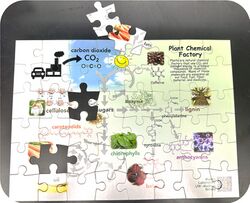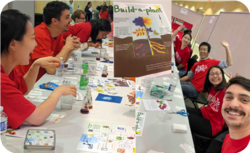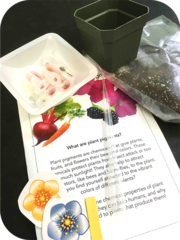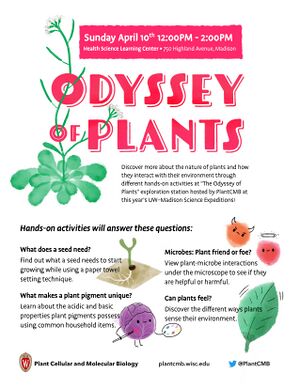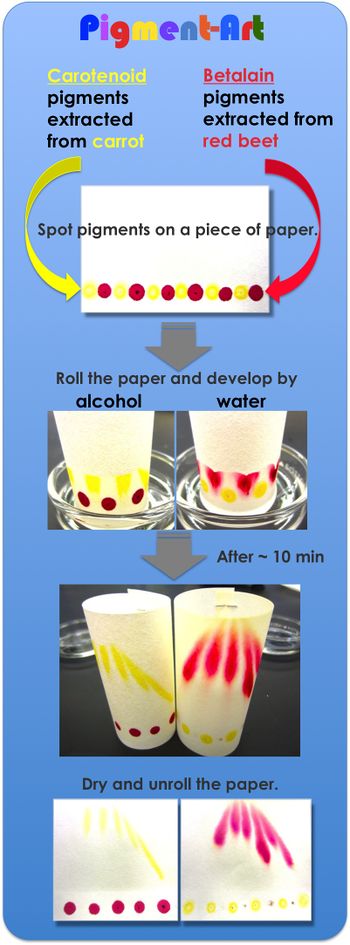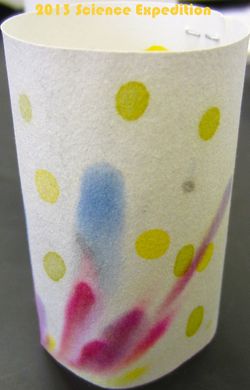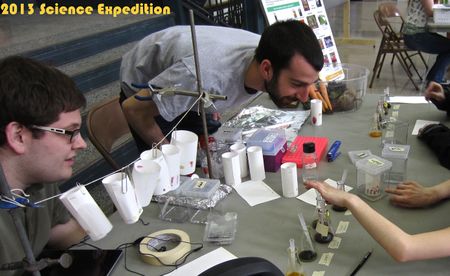Difference between revisions of "Maeda Lab:Outreach"
| (22 intermediate revisions by the same user not shown) | |||
| Line 1: | Line 1: | ||
| − | [[Image: | + | [[Image:Maeda_lab_banner_2020.jpg|800px]] |
<div style="padding: 10px; color: #ffffff; background-color: #4B6A89; width: 780px"> | <div style="padding: 10px; color: #ffffff; background-color: #4B6A89; width: 780px"> | ||
<center> | <center> | ||
| − | [[Main_Page| <font face=" | + | [[Main_Page| <font face="Georgia" style="color:#ffffff" size=4> '''Home''' </font>]] |
| − | [[Maeda Lab:Research | <font face=" | + | [[Maeda Lab:Research | <font face="Georgia" style="color:#ffffff" size=4> '''Research''' </font>]] |
| − | [[Maeda Lab:Lab | + | [[Maeda Lab:Outreach | <font face="Georgia" style="color:#ffffff" size=5> '''Outreach''' </font>]] |
| − | [[Maeda Lab: | + | [[Maeda Lab:Diversity | <font face="Georgia" style="color:#ffffff" size=4> '''Diversity''' </font>]] |
| − | [[Maeda Lab: | + | [[Maeda Lab:Lab Members | <font face="Georgia" style="color:#ffffff" size=4> '''Team''' </font>]] |
| − | [[Maeda Lab: | + | [[Maeda Lab:Publications | <font face="Georgia" style="color:#ffffff" size=4> '''Pubs''' </font>]] |
| + | [[Maeda Lab:Protocols | <font face="Georgia" style="color:#ffffff" size=4> '''Protocols''' </font>]] | ||
</center> | </center> | ||
</div><br> | </div><br> | ||
| Line 14: | Line 15: | ||
|-valign="top" | |-valign="top" | ||
|style="background:#ffffff"| | |style="background:#ffffff"| | ||
| − | <h3><font>Maeda Lab | + | |
| − | In plants, '''aromatic amino acids''' are used to make colorful pigments, such as anthocyanins and betalains. These pigments also have important nutritional and pharmacological value to humans. To help disseminate the broader impact of our plant metabolism research in general public, we | + | |
| + | <h3><font>Maeda Lab is back to Huegel Elementary Science Night! - April 23rd, 2024</font></h3> [[Image:puzzle.jpg|right|250px|]] | ||
| + | We will be back to the Huegel Elementary School this time in person! (2022 was online outreach) We will be using natural pigments that the Maeda lab extracted from different plants and studying their chemical features and importance in our human well-being. We will also bring a plant metabolic pathway puzzle (see pic) for those of you who are curious about how these plant chemicals are made from CO2 and sunlight energy. | ||
| + | |||
| + | *If you would like to explore pigments from plants in your kitchen, here is [https://docs.google.com/document/d/19rIT61LZhXWB3k6gu-GUsBa2x7O6Y8Bn7YIE2AZcVRY/edit how you can extract pigments from plant tissues at home]. | ||
| + | |||
| + | |||
| + | <h3><font>PlantCMB outreach, “Build-a-Plant”, at UW Science Expedition - April 17, 2023</font></h3> [[Image:SciExp2023.png|right|250px|]] | ||
| + | The Maeda Lab led the outreach event called “Build-a-plant”, together with five other laboratories of the PlantCMB group on UW campus to work with local children and parents about various aspects of plant science, where our lab used plant pigments and metabolic pathway puzzles to explain how diverse chemicals are produced in different plant species. Ian from our lab created the stickers that were given to each participant upon finishing an activity, assembling them to construct a plant from the roots upwards. Despite it being a cold, wet, blustery day (April in Wisconsin!) the action at the tables was nonstop for three hours. We certainly filled the Health Science Learning Center with a lot of excitement about plants! Thank you many of you who participated and visited our outreach! | ||
| + | |||
| + | [[Image:beeeet.png|right|80px|]] | ||
| + | <h3><font>Science Night at Anana Elementary School - April 13, 2023</font></h3> | ||
| + | The Maeda lab also carried out a Science Night outreach event at Milele Chikasa Anana Elementary School in the city of Madison. We conducted "Pigment Art" activity with children, who carried out paper chromatography/chemical reactions with plant pigments to learn about their properties and their importance in our society. | ||
| + | |||
| + | <h3><font>Huegel Elementary Science Night - April 19, 2022</font></h3> [[Image:PigmentKit.png|right|180px|]] | ||
| + | Welcome to the submission page for the '''plant growth and pigment challenge'''! | ||
| + | *Please send us a photo of your flowers to Madelyn <'''[mailto:schaut2@wisc.edu schaut2@wisc.edu]'''> and [https://docs.google.com/forms/d/e/1FAIpQLSe1-tM-sXgBVs3lEzP2p__BDWAqEbPTK0Se80vNg2aVGEMYpA/viewform?vc=0&c=0&w=1&flr=0&usp=mail_form_link '''click here to tell us which flowers produce carotenoids, anthocyanins or betalains'''], if you found out! | ||
| + | *If you would like to explore pigments from plants in your kitchen, here is [https://docs.google.com/document/d/19rIT61LZhXWB3k6gu-GUsBa2x7O6Y8Bn7YIE2AZcVRY/edit how you can extract pigments from plant tissues at home]. | ||
| + | *Thanks again for joining the virtual plant pigment event! (Maeda Lab members :-) | ||
| + | |||
| + | |||
| + | <h3><font>PlantCMB outreach at UW Science Expedition, April 10, 2022</font></h3> [[Image:plantCMB-sciexp-2022.jpg|right|300px|]] | ||
| + | Multiple labs from the UW PlantCMB group participated the 2022 UW Science Expedition. We had a lot of fun interacting with many children and parents! | ||
| + | |||
| + | <h3><font>2021 Virtual UW Science Expedition</font></h3> [https://www.thinglink.com/scene/1426353628074999809 link] | ||
| + | During COVID-19 pandemic, Tadhg Young, Beth Moore, and Bailey Kleven generated an outreach video to demonstrate how to extract and study chemical properties of different plant pigments ([https://www.youtube.com/watch?v=z0F66xFJmeo see the video here]). | ||
| + | |||
| + | <h3><font>Why Maeda Lab runs outreach events?</font></h3> [[Image:pigment_art.jpg|right|350px|]] | ||
| + | In plants, '''aromatic amino acids''' are used to make colorful pigments, such as anthocyanins and betalains. These pigments also have important nutritional and pharmacological value to humans. To help disseminate the broader impact of our plant metabolism research in general public, we have been presenting an outreach event called “'''Pigment-Art'''” and related activities. | ||
'''What is “Pigment-Art”?''' | '''What is “Pigment-Art”?''' | ||
| Line 22: | Line 51: | ||
*We also hope to share information on '''the use of plant natural resources in our food, medicine, and many other aspects of human life'''. For example, the natural pigments provide attractive colors and also nutritional/medicinal properties to our food: Carotenoids are yellow/red pigments also essential for our vision as pro-vitamin A. Scientists believe that it is not coincident that these pigments have beneficial effects on human health. During evolution plants have used the color to attract seed dispersers at the time fruits reach to maturity and are ready to be picked. Animals in turn associate the color to the beneficial ingredients that are accumulated in the fruits. Unfortunately, in the past decades, petroleum-based synthetic chemistry provided cost-effective artificial dyes and replaced many of the natural pigments from our diets. As the synthetic pigments generally lack the nutritional and pharmacological activities, our current diet have significantly reduced nutritional values, while our brain may still mistakenly perceive that we obtain nutrients that are represented by the color. | *We also hope to share information on '''the use of plant natural resources in our food, medicine, and many other aspects of human life'''. For example, the natural pigments provide attractive colors and also nutritional/medicinal properties to our food: Carotenoids are yellow/red pigments also essential for our vision as pro-vitamin A. Scientists believe that it is not coincident that these pigments have beneficial effects on human health. During evolution plants have used the color to attract seed dispersers at the time fruits reach to maturity and are ready to be picked. Animals in turn associate the color to the beneficial ingredients that are accumulated in the fruits. Unfortunately, in the past decades, petroleum-based synthetic chemistry provided cost-effective artificial dyes and replaced many of the natural pigments from our diets. As the synthetic pigments generally lack the nutritional and pharmacological activities, our current diet have significantly reduced nutritional values, while our brain may still mistakenly perceive that we obtain nutrients that are represented by the color. | ||
| − | |||
| − | |||
| − | |||
| − | |||
| − | |||
| − | |||
| − | |||
| − | |||
| − | |||
| − | |||
| − | |||
| − | |||
'''If you have any questions regarding the event, please contact Hiroshi Maeda [mailto:maeda2@wisc.edu maeda2@wisc.edu].''' | '''If you have any questions regarding the event, please contact Hiroshi Maeda [mailto:maeda2@wisc.edu maeda2@wisc.edu].''' | ||
Latest revision as of 12:05, 16 April 2024
|
Contents
Maeda Lab is back to Huegel Elementary Science Night! - April 23rd, 2024We will be back to the Huegel Elementary School this time in person! (2022 was online outreach) We will be using natural pigments that the Maeda lab extracted from different plants and studying their chemical features and importance in our human well-being. We will also bring a plant metabolic pathway puzzle (see pic) for those of you who are curious about how these plant chemicals are made from CO2 and sunlight energy.
PlantCMB outreach, “Build-a-Plant”, at UW Science Expedition - April 17, 2023The Maeda Lab led the outreach event called “Build-a-plant”, together with five other laboratories of the PlantCMB group on UW campus to work with local children and parents about various aspects of plant science, where our lab used plant pigments and metabolic pathway puzzles to explain how diverse chemicals are produced in different plant species. Ian from our lab created the stickers that were given to each participant upon finishing an activity, assembling them to construct a plant from the roots upwards. Despite it being a cold, wet, blustery day (April in Wisconsin!) the action at the tables was nonstop for three hours. We certainly filled the Health Science Learning Center with a lot of excitement about plants! Thank you many of you who participated and visited our outreach! Science Night at Anana Elementary School - April 13, 2023The Maeda lab also carried out a Science Night outreach event at Milele Chikasa Anana Elementary School in the city of Madison. We conducted "Pigment Art" activity with children, who carried out paper chromatography/chemical reactions with plant pigments to learn about their properties and their importance in our society. Huegel Elementary Science Night - April 19, 2022Welcome to the submission page for the plant growth and pigment challenge!
PlantCMB outreach at UW Science Expedition, April 10, 2022Multiple labs from the UW PlantCMB group participated the 2022 UW Science Expedition. We had a lot of fun interacting with many children and parents! 2021 Virtual UW Science ExpeditionlinkDuring COVID-19 pandemic, Tadhg Young, Beth Moore, and Bailey Kleven generated an outreach video to demonstrate how to extract and study chemical properties of different plant pigments (see the video here). Why Maeda Lab runs outreach events?In plants, aromatic amino acids are used to make colorful pigments, such as anthocyanins and betalains. These pigments also have important nutritional and pharmacological value to humans. To help disseminate the broader impact of our plant metabolism research in general public, we have been presenting an outreach event called “Pigment-Art” and related activities. What is “Pigment-Art”?
|

